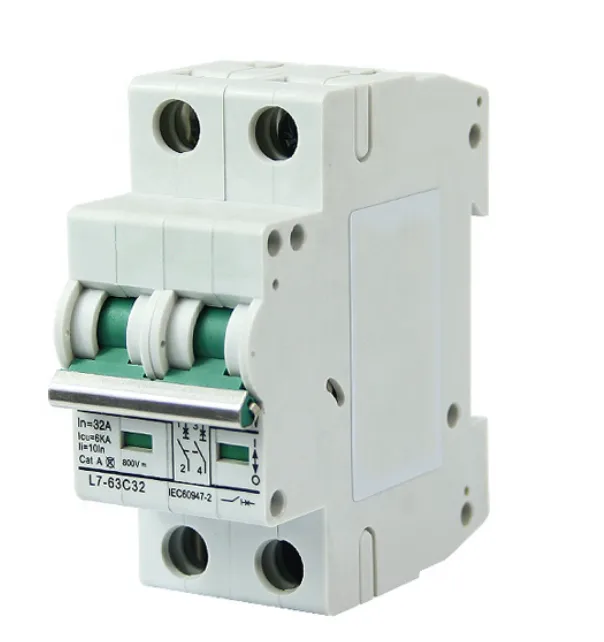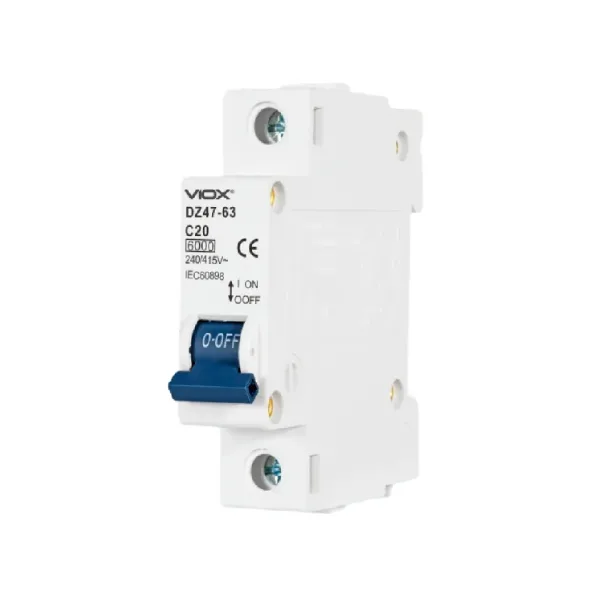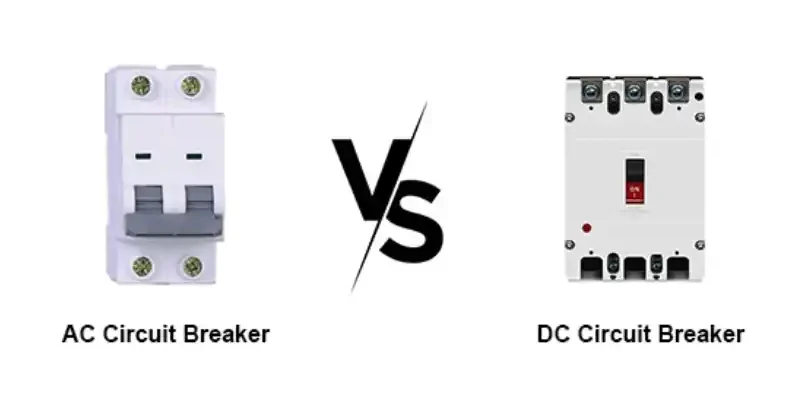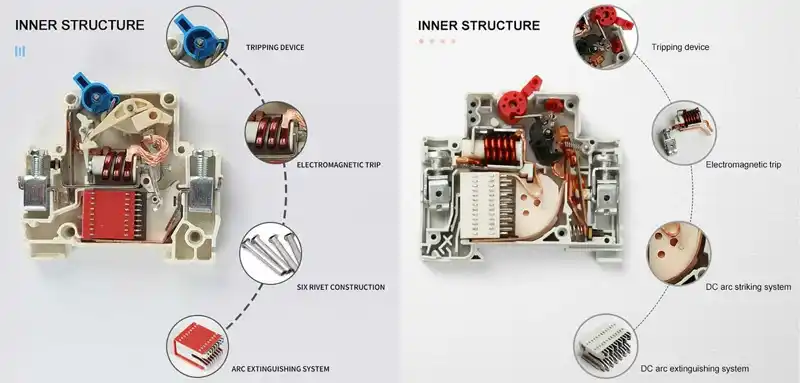
What Are DC and AC Circuit Breakers?
DC Circuit Breakers Defined

A DC breaker is a device that protects equipment from damage caused by accidental contact with direct current. It is an important safety mechanism in electrical systems. DC circuit breakers are specifically engineered to handle the unique challenges of direct current systems where electricity flows continuously in one direction.
Key characteristics of DC systems:
- Current flows in a single, constant direction
- Voltage remains steady (doesn’t alternate)
- Common in solar panels, batteries, and electric vehicles
- Requires specialized interruption techniques
AC Circuit Breakers Defined

An AC breaker is an over-current protection device that operates with alternating current. This current changes direction many times in a second – 50 or 60 times, depending on the power system’s frequency.
Key characteristics of AC systems:
- Current alternates direction 50-60 times per second
- Voltage crosses zero twice per cycle
- Standard in residential and commercial buildings
- Easier to interrupt due to natural zero crossings
Critical Differences Between DC and AC Circuit Breakers
Arc Extinguishing: The Fundamental Difference
Unlike AC, DC current does not naturally pass through a zero point, making it harder to interrupt and extinguish the arc. Therefore, DC circuit breakers require a more complex design to effectively extinguish the arc.
AC Arc Extinction:
- Because AC power alternates between positive and negative voltage, there are two points in every cycle where the voltage is zero. When the contacts separate and an arc forms, the arc disappears within 1/120th of a second.
- Natural zero crossings assist in breaking the circuit
- Simpler internal design requirements
DC Arc Extinction:
- In direct current where voltage is continuous, the electric arc is constant and more resistant to interruption. For this reason, DC circuit breakers must include additional arc extinguishing measures: they typically have a mechanism to elongate and dissipate the electric arc in order to simplify interruption.
- Requires magnetic blowout coils or special contact geometry
- More complex and expensive construction
Voltage and Current Handling Capabilities
Here is a table that shows the key technical differences between DC and AC circuit breakers:
| 기능 | DC 회로 차단기 | AC Circuit Breakers |
|---|---|---|
| 아크 소멸 | Specialized for DC power: Compared with traditional AC breakers, they have more advantages in handling DC arcs, can effectively extinguish arcs | Natural zero-crossing assistance |
| 전압 등급 | DC voltages can run up to 600 volts on residential and 1,000 or 1,500 volts on commercial projects | Standard 120V, 240V, 480V ratings |
| 연락처 디자인 | There are two main contacts for DC and three for AC | Three main contacts for AC systems |
| Price Point | Higher price: Due to the special design and material requirements of DC breakers, their prices are usually higher than traditional AC circuit breakers | 더 간단한 디자인으로 인해 비용이 낮아졌습니다. |
| 크기 요구 사항 | Large size: Some types of DC circuit breakers may be larger and occupy more installation space due to their arc extinguishing and heat dissipation requirements | Compact standard sizes |
Safety Standards and Certifications
UL 489 Standards:
This standard covers devices rated at 1000 volts ac and 1500 volts dc or less and 6000 amperes or less. Both DC and AC circuit breakers must meet rigorous safety testing, but UL 489 certification is the highest safety standard for MCBs. It’s specifically designed for branch/standalone circuit protection.
Applications: When to Use DC vs AC Circuit Breakers
DC Circuit Breaker Applications
태양광 발전 시스템:
- DC breakers are particularly important in scenarios with high safety and reliability requirements, such as photovoltaic power generation
- Required by NEC codes for Solar+Storage projects
- Handle high voltages from solar panel strings
전기 자동차 충전:
- Electric vehicles (EVs): Demand compact, high-performance breakers capable of handling high DC currents
- Critical for fast-charging stations
- Battery protection in EV systems
배터리 스토리지 시스템:
- DC circuit breakers have a crucial role in protecting battery banks, solar PV arrays, inverters, and more
- Prevent thermal runaway in lithium batteries
- Essential for off-grid power systems
Industrial and Railway Applications:
- Industrial and railway applications: Require heavy-duty breakers with high breaking capacity
- Motor control in DC drive systems
- Heavy machinery protection
AC Circuit Breaker Applications
Residential and Commercial Buildings:
- AC breakers are prevalent in grid-connected electrical systems
- Standard in homes and offices
- Protect household appliances and lighting circuits
Grid-Connected Systems:
- Main electrical panel protection
- Feeder and branch circuit protection
- Industrial motor control (AC motors)
How to Select the Right Circuit Breaker
DC Circuit Breaker Selection Criteria
1. Voltage Rating Selection:
The breaker should be rated for the maximum voltage of the solar panels or the string of panels. For example 12V DC circuit breaker, 24V DC circuit breaker, and others.
⚠️ Safety Warning: Always use a breaker specifically rated for DC voltage and current. Choose a breaker with a voltage rating equal to or greater than your system’s maximum DC voltage.
2. Current Rating Calculation:
The breaker should be rated for the maximum current that the solar panel or the string of panels can generate under normal operating conditions. For example: 100 amp DC breaker, 100 A DC breaker, 200 amp DC breaker, DC breaker 250A, and others.
3. Breaking Capacity Requirements:
Breaking capacity is the maximum current that a circuit breaker can safely break without damage. This is especially critical for battery systems where short-circuit currents can be extremely high.
Interrupting Capacity by Voltage
Here is a table that shows typical DC circuit breaker interrupting capacities:
| 시스템 전압 | Typical Interrupting Capacity | 일반적인 애플리케이션 |
|---|---|---|
| 12V 직류 | 5000A @12V | Automotive, RV, small solar |
| 24V DC | 3000A @ 24V | Marine, telecommunications |
| 48V DC | 1500A @ 42V | Data centers, telecom |
| 125V DC | 10,000-25,000A | 산업 시스템 |
| 600V DC | 14,000-65,000A | Large solar arrays |
AC Circuit Breaker Selection Criteria
1. Standard Voltage Ratings:
- 120V for residential lighting and outlets
- 240V for large appliances and HVAC
- 480V for commercial and industrial applications
2. Current Rating Formula:
Calculate based on 125% of expected load current per NEC requirements:
Breaker Rating = Load Current × 1.25
3. Interrupting Capacity:
- Residential: 10,000 AIC typical
- Commercial: 22,000-65,000 AIC
- Industrial: Up to 200,000 AIC for high-fault applications
Code Compliance and Safety Requirements
국가 전기 규정(NEC) 요구 사항
DC Circuit Requirements:
Where INSIDE buildings, PV system DC circuits that exceed 30 volts or 8 amperes must be contained IN metal raceways, or Type MC metal-clad cable that complies with 250.118(10), or in metal enclosures.
Voltage Limitations:
One- and two-family dwellings are still limited to 600Vdc circuits, and other buildings are still limited to 1,000Vdc circuits.
Required Labeling:
The following wiring methods and enclosures that contain PV system dc circuit conductors shall be marked with the wording PHOTOVOLTAIC POWER SOURCE or SOLAR PV DC CIRCUIT by means of permanently affixed labels.
전문적인 설치 요구 사항
🔧 Expert Tip: High installation requirements: Since DC circuit breakers handle DC, their installation and wiring requirements are high, especially in high-voltage applications, requiring professional installation and maintenance personnel.
UL Listing Requirements:
- All circuit breakers must be UL Listed
- UL 489 devices are evaluated and “Listed” for use as a standalone product
- Match breaker ratings to specific applications
일반적인 문제 해결
DC System Problems
Arc Welding Effect:
If a DC circuit breaker cannot interrupt the arc properly, contacts can weld together. This dangerous condition requires immediate professional attention.
전압 정격 불일치:
Using an 80VDC breaker on a 48VDC nominal system might not be adequate as the solar array Open Circuit Voltage (Voc) can be in excess of 88VDC before temperature correction.
AC System Problems
Nuisance Tripping:
Often caused by overloaded circuits or equipment with high starting currents. Solution: Upgrade to higher-rated breaker or reduce circuit load.
Poor Contact Issues:
In high-moisture environments, a special moisture treatment is recommended for breakers. This treatment helps resist mold and/or fungus that can corrode the unit.
환경적 고려 사항
온도 효과
High-Temperature Applications:
If standard thermal magnetic breakers are applied in temperatures exceeding 104° F, the breaker must be derated or recalibrated to the environment.
IP Rating Requirements
For outdoor installations, select breakers with appropriate IP ratings:
- IP65: Dust-tight and water-resistant
- IP67: Submersion-resistant for harsh environments
- 네마 4X: Corrosion-resistant for marine applications
빠른 선택 가이드
For Solar Power Systems
- DC breakers required for solar panel strings
- Voltage rating ≥ system’s maximum open-circuit voltage
- Current rating = 125% of maximum panel output
- Must meet UL 489I certification requirements for solid-state circuit breakers if using advanced technology
For Residential Applications
- AC breakers for all household circuits
- Standard 120V/240V ratings
- AFCI/GFCI protection where required by code
- 전문가 설치 권장
For Electric Vehicle Charging
- DC breakers for battery protection
- AC breakers for charging station supply
- High interrupting capacity required
- Temperature derating may be necessary
자주 묻는 질문
Q: Can I use an AC circuit breaker in a DC system?
A: Using an AC circuit breaker in a DC system can pose safety risks and may not effectively interrupt fault currents. Always use the appropriate type of circuit breaker for the specific system to ensure safety and proper operation.
Q: Why are DC circuit breakers more expensive than AC breakers?
A: Due to the special design and material requirements of DC breakers, their prices are usually higher than traditional AC circuit breakers. The complex arc-extinguishing mechanisms and specialized materials increase manufacturing costs.
Q: What voltage ratings are available for DC circuit breakers?
A: DC circuit breakers are available in various ratings from 12V for automotive applications up to 1500 volts dc or less for industrial and solar applications.
Q: Do I need special training to install DC circuit breakers?
A: Yes, especially for high-voltage applications. High installation requirements: Since DC circuit breakers handle DC, their installation and wiring requirements are high, especially in high-voltage applications, requiring professional installation and maintenance personnel.
Q: How do I calculate the right size DC circuit breaker for my solar system?
A: The breaker should be rated for the maximum current that the solar panel or the string of panels can generate under normal operating conditions. Use manufacturer specifications and apply NEC 125% derating factor.
Q: What’s the difference between UL 489 and UL 1077 ratings?
A: UL 489 certification is the highest safety standard for MCBs. It’s specifically designed for branch/standalone circuit protection while UL 1077 covers supplementary protectors for use within equipment.
Q: Can one circuit breaker work for both AC and DC applications?
A: c3controls Series 1100 UL 489 Branch Circuit Breakers and UL 1077 Supplementary Protectors can handle both AC circuits and DC circuits. However, the operating voltages differ greatly. Special dual-rated breakers exist but have significantly different voltage ratings for AC vs DC operation.
Q: What happens if I use the wrong type of circuit breaker?
A: Using the incorrect breaker type can result in failure to interrupt fault currents, potential fire hazards, code violations, and equipment damage. It’s absolutely crucial to use the right type of breaker for a specific electrical system to ensure safety and reliable protection for the circuit.
전문가 추천
⚡ 안전 우선: Never attempt to interchange AC and DC circuit breakers. The fundamental differences in arc extinction and current characteristics make this extremely dangerous.
🔍 규정 준수: Always verify local electrical codes and NEC requirements for your specific application. DC systems have special requirements for conductor protection and labeling.
🛠️ 전문가 설치: For systems over 50V DC or any commercial applications, engage a qualified electrician familiar with DC system requirements.
📋 선적 서류 비치: Maintain detailed records of circuit breaker specifications, installation dates, and test results for safety and warranty purposes.
Understanding the critical differences between DC and AC circuit breakers ensures safe, code-compliant electrical installations. Whether you’re designing a solar power system, upgrading residential circuits, or planning industrial applications, selecting the right circuit breaker type and rating is essential for equipment protection and human safety.
For complex installations or when in doubt about breaker selection, always consult with qualified electrical professionals who understand the specific requirements of your application and local electrical codes.



